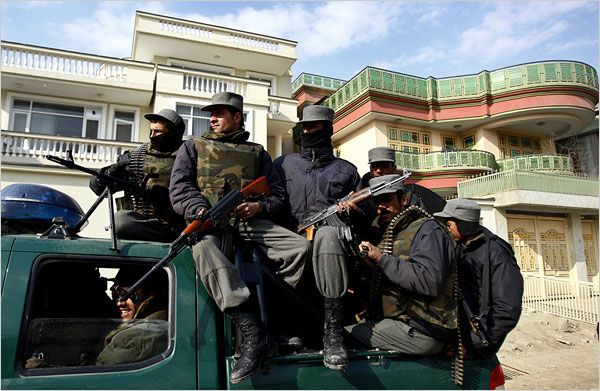
| THE HANDSTAND | LATE AUTUMN2008 |

"To the villagers here, there is no doubt what
happened in an American airstrike on Aug. 22: more than
90 civilians, the majority of them women and children,
were killed. The Afghan government, human rights and
intelligence officials, independent witnesses and a
United Nations investigation back up their account,
pointing to dozens of freshly dug graves, lists of the
dead, and cellphone videos and other images showing
bodies of women and children laid out in the village
mosque. Cellphone images seen by this reporter show at
least 11 dead children, some apparently with blast and
concussion injuries, among some 30 to 40 bodies laid out
in the village mosque. Ten days after the airstrikes,
villagers dug up the last victim from the rubble, a baby
just a few months old. Their shock and grief is still
palpable. For two weeks, the United States military has
insisted that only 5 to 7 civilians, and 30 to 35
militants, were killed in what it says was a successful
operation against the Taliban: a Special Operations
ground mission backed up by American air support. But on
Sunday, Gen. David D. McKiernan, the senior American
commander in Afghanistan, requested that a general be
sent from Central Command to review the American military
investigation in light of “emerging evidence.”""
WWW.ANGRYARAB.BLOGSPOT.COM
Afghan President Hamid Karzai has criticised US forces for "unilateral operations" in the west which, the government says, killed at least 70.
A spokesman for the US task force, that operates outside Nato, said an inquiry was under way. They had initially denied any civilians had been killed.
Tribal elders said a bomb had been dropped on mourners at a wake in Herat.
Afghan officials clamp down on the press
Government agencies are intimidating and arresting journalists. The crackdown marks the decline of a hard-won, post-Taliban-era achievement: press freedom.
By Anand Gopal | Correspondent of The Christian Science Monitorfrom the August 19, 2008 edition
Correspondent Anand Gopal talks about the reaction by Afghan journalists to threats and harassment by government agencies.
Kabul, Afghanistan - Naseer Fayaz, one of Afghanistan's most famous television presenters, is used to fans and other well-wishers coming by the office. The host of a popular weekly program, "The Truth," his exposÚs of government malfeasance have won him awards as well as a devoted following. But after a recent episode of the show that was especially critical of the government, Mr. Fayaz received unexpected visitors: members of the Afghan secret police.
"They questioned me and the next day arrested me," he says. "I was kept in a cell for two days. They kept telling me I should quit working in the media."

After protests from numerous Afghan media groups and global organizations, such as Amnesty International, Fayaz was released. But media groups say that the incident is the latest in a trend of increasing intimidation of Afghan journalists by the government.
In fact, the Afghan government is responsible for at least 23 of the 45 reported incidents of intimidation, violence, or arrest of journalists between May 2007 and May 2008, according to the Nai Center for Open Media, an Afghan nongovernmental organization.
The figure represents a 130 percent spike from the same period the year before, when just 10 cases were reported. Since May, 22 incidents of press harassment have been reported, nearly a 60 percent jump from the same period last summer.
Only a few weeks ago, authorities arrested Raj – like many Afghans, he goes by only one name – the manager of the independent outlet Nili Radio in Daikundi Province. Mr. Raj told reporters that he was arrested because he did not provide enough coverage of the activities of the local governor.
"Even independent news outlets are under tremendous pressure," says Hafiz Barakzai, assistant director of the National Union of Journalists. "If news directors or editors write something critical of the government, they will be sure to get a call from a government official." Mr. Barakzai adds that dozens of journalists have been fired because they failed to curb their reporting to meet government demands.
For example, Sohaila Wedah Khamoush, a reporter for the independent daily Payman, says she has been repeatedly abused by police and government officials. "I saw police beating protesters in an anti-US demonstration," she says. "When I tried to take pictures I was sent to the attorney general's office and he arrested me. He eventually released me and ordered me not to write the story."
Last month, according to the Nai Center, authorities released Khalil Narmgoy, who had spent 35 days in jail after being accused of writing a satire criticizing President Hamid Karzai.
The office of Mr. Karzai and the National Directorate of Security – the agency behind many of the recent arrests – were not available for comment.
A short-lived media boom
The Afghan media industry had boomed after the fall of the Taliban in 2001. Media freedom was unprecedented in the country's history and widely hailed as one of the most important civil achievements in the post-Taliban era. Today, there are close to 770 newspapers and magazines across the country, according to Barakzai of the Union of Journalists.
But now, some question the independence of Afghan media outlets. "Eighty to 90 percent of newspapers are supported by ex-mujahideen commanders and other strongmen who are very politically minded," says Barakzai. "If the news director writes something these politicians don't like, he will lose his job."
The Afghan government maintains that it respects freedom of speech and that journalists are only arrested or forced out of jobs when they violate the media code of conduct. "There are some circles [in the government] that would like to restrict media freedoms, but also some journalists who violate the principles of their profession," says Afghan Vice President Karim Khalili.
Abdul Wakhil Omari, a senior official at the Afghan Supreme Court, adds, "Of course it would be best if journalists weren't arrested, but they shouldn't overstep their bounds, either."
National security versus press freedom
Some officials argue that these bounds are crossed when critical reporting weakens the central government and strengthens the Taliban. They point out that given present security conditions reporters also have an obligation to protect the national interest.
"The media does not reflect the achievements of the government," Sadeq Mudaber, the deputy director of general policy, told reporters in November. "Although the media law guarantees freedom of press, the national interests of the country should be a priority over anything else."
United Nations spokesman Aleem Siddique points out that the deteriorating security situation and resulting decline of public support for official policies is affecting the government's capacity to deal with criticism.
Sediqullah Tauhidi, manager of the Nai Center, adds: "The government stance towards media is much different than last year ... because it has grown weaker and lost support. As it grows weaker, it will feel the need to lash out against critical press coverage."
Off the airwaves
Television personality Fayaz, meanwhile, has gone into hiding, citing fears for his life. "My family called me and told me that some mysterious armed men were lurking outside my house," he says. "I'm under risk and I can't continue airing my program. There are a lot of powerful interests against me. If this is how they treat the media, I want to leave Afghanistan and not come back."